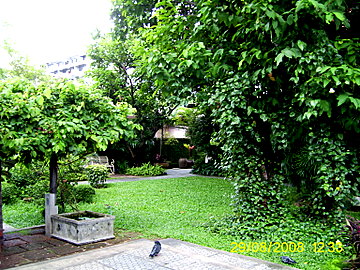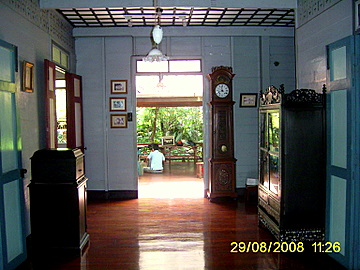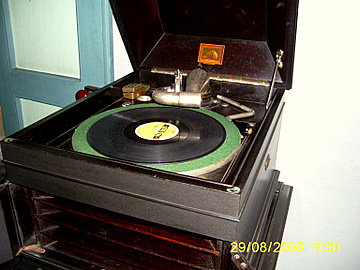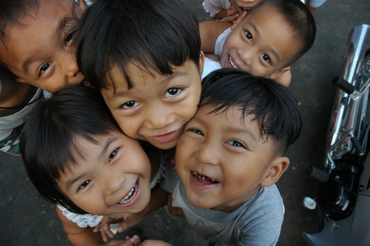The family home was converted to the Bangkok Folk Museum to preserve the lifestyle of early Bangkok and also to record the history of Bangkok and the Bangrak district, where the museum is located. On 1 October 2004, the property was donated to the Bangkok Metropolitan Authority who now manages the place.
There are four buildings set in a lush garden in half an acre of land in the busy commercial Bangrak district near the Chao Phraya River.

The lush garden
Three of these building are open for public viewing. Ms Waraporn Surawadee, daughter of the original owners, lives in the fourth and it was through her dedicated efforts that the Bangkok Folk Museum was established.
The first building, which used to be the family home, is a two storey wooden building with a covered verandah at the back. The ground floor consists of an anteroom connecting to the dining room, guest room and library.

At the entrance to the house
There’s an air of nostalgia in the house where there’s a grandfather clock and an old gramophone that has to be started by a lever. On my first visit in 2004, an old 75-rpm record of “Would I Love You” by Doris Day and Harry James was still on the turntable. The record has been changed when I revisited the museum in August 2008.

Music of yesteryears
The dining room has a collection of European porcelain around the 1899 – 1913 period and old Chinese ceramics.
It's not an old palace, or a past royal residence, nor a teak house dragged from up-country and reassembled in the city - but that's its charm. Situated not far from the Central Post Office, the Bangkok Folk Museum is a typical Bangkok family house, the only difference being that this one is typical of over 70 years ago.
Together its interiors and original household items, including traditional household utensils and items of ceremonial significance, present a 'living scenario of middleclass Bangkok citizens in the period of World War II'. Everything is classified and exhibited with the efficiency and precision of a much larger museum, and owner Mrs Waraporn Surawadee can arrange guided tours.
Open: 10:00 - 17:00 (weekends only)
Where: 273 Charoenkrung Soi 43
Admission: free (contact owner Mrs Waraporn Surawadee 09:00 - 17:00 Monday to Friday for bookings).
Contact: +66 (0)2 233 7027

.jpg)


 The mysteries of our magical world, demystified
The mysteries of our magical world, demystified




![HARPER'S WEEKLY [March 30, 1878]](http://i54.photobucket.com/albums/g101/apgts/welcomemuseum/harpers.jpg)


































